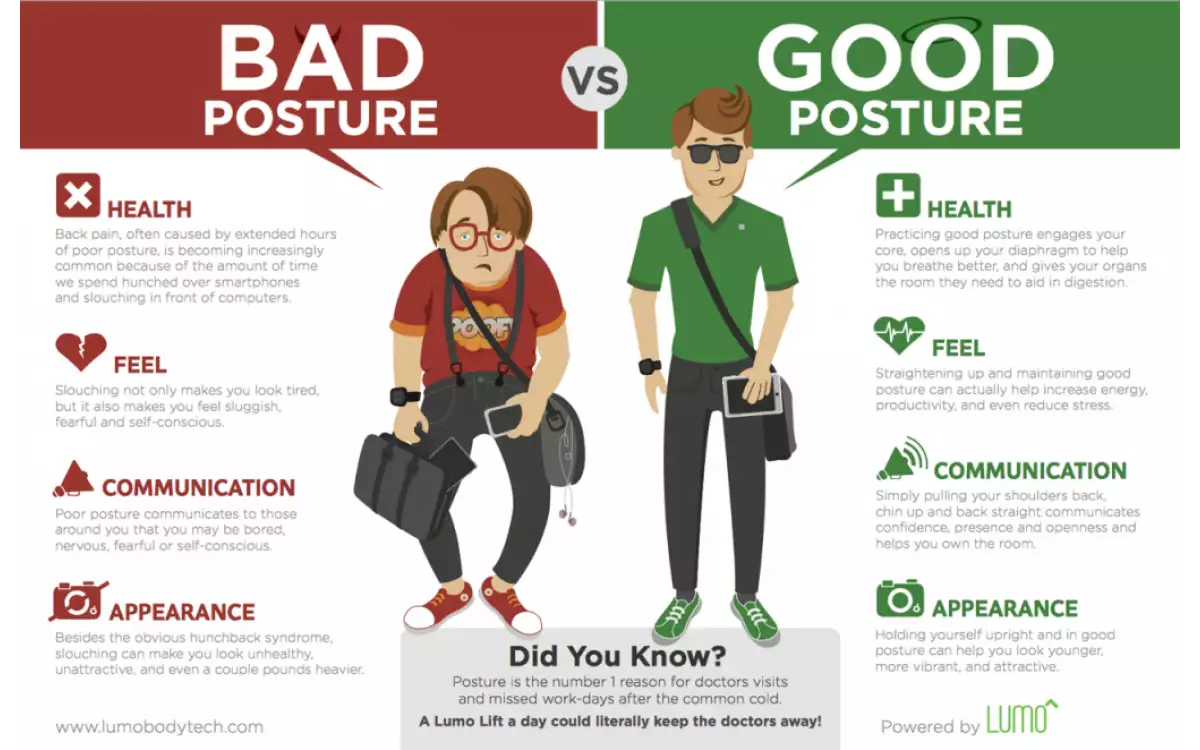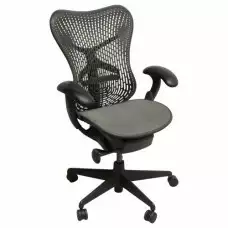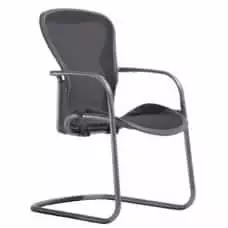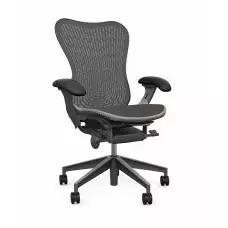When you go to a driving range or just happen to come across a sports channel covering professional golfing tournaments, you will see how the golfers drive a ball. The average driving distance for a regular golfer ranges from 150 to 250 yards. If those numbers are not impressive enough for you, here are those same numbers in feet: 450 to 740 feet. Golf is not only a strength and endurance-centered sport, but it is also precision-heavy. Pay attention to how those golfers are standing: feet planted on the ground, standing, and bent forward from the hips. This position is held while the golfer brings back his club in preparation for the hit and releases it once the club has made contact with the ball. Posture is a vital aspect in golf. Hitting the ball with just brute strength will not produce the same effect as the right posture would.
Posture does not only find its value in golf, but also in everybody's daily life.
You notice that back pain? Posture.
You have neck pains? Another point for posture!
You feel out of breath more than usual? Most likely posture.
The list is endless.
Posture is linked to a lot of aspects of the human body and mind.
You will sometimes catch yourself feeling sore on your neck, back, or even shoulders and then changing the way you were standing or sitting. You are unconsciously changing up your posture. Being in the same position for long periods of time will generate such pains.
What is posture exactly?
Posture is the way you are holding your body while sitting or standing. People develop their postures to fit their preference of comfort. That is the general idea, but there is more to it than just that. Posture is one of the embodiments of good health. Why is that? Many studies have been conducted to link posture to a variety of health concerns ranging from a stronger back, flexibility, and blood circulation amongst other things. As posture is developed on its own, people often inherently cultivate poor posture habits.
What constitutes a "good" posture?
A good posture is all about keeping your body straight and vertical to the ground, thus affecting how gravity acts on your body in whatever position it is in. Gravity is a force that is always acting against you as it is pushing you down towards the earth. The effect it has on your body can be straining when you are not working with the force. The muscles and bones in your body are constantly exerting energy to keep you upright. You can help your body out a bit if you position it in ways that will distribute the energy and stress to the correct places. Working with gravity in the sense that you are correcting yourself by not slouching, keeping your back straight, feet straight up on the ground, etc. will lessen the pressure on your joints, ligaments, and muscles.
Daily posture mistakes.
With the way the world is progressing - towards a more technological future - people often find themselves sitting on their chairs for hours straight just trying to get their work done for the day. Without paying close attention to how they are sitting, people develop poor posture without a constant reminder to correct themselves. When you finally move after standing or sitting for a long period of time you will notice that you get sore. Try to vary your positions in order to avoid this. It will keep your muscle awake in the sense that it is not being held in the same position, which can tire it out. The best types of chairs to utilize at work would be ones that have lumbar support and adjustable arm-rests -- Beverly Hills Chairs always has great deals on the best rated, ergonomically friendly chairs.
As you are sitting in front of a computer, you may eventually notice that your shoulders are tensed up and you will not remember how long they have been there until you feel the burn after relaxing them. You may also find yourself leaning towards your monitor trying to get closer to the action. Holding this position for a long period will not only put your back in discomfort but will also strain your neck. Keeping good posture is somewhat difficult to come by nowadays.
Do be careful when trying to lift heavy objects. If not mindful of your body taking on the burden of whatever it is you are carrying, you can seriously injure your back. This is usually the case when people are holding said object away from the body. All of your carrying strength is at the core of your body. You will want the object as close to your core as much as possible as your body's strength and energy will not have to travel too far to keep the object above ground.

Why you should think twice about your posture.
When you fix up your posture to be the ideal of postures you will notice small, but significant, improvements to your body. You will experience less pain in certain areas of your body, such as the back and the neck, for starters. Your organs will function at their most optimal of levels as they have the proper space, given to them by good posture, to service your body.
Here are a few more details on benefits of a good and healthy posture:
Joints, ligaments, and muscles. Good posture will improve the efficiency and decrease the wear and tear of these body components. Think of posture as a support system for your body. These guys work hard to keep you up and about. Reward them with improvements to your posture. They will definitely appreciate it and you will feel less pain in problem areas that come with slouching. Slouching can lead you to develop adverse health complications. Back pain is the most common of issues. If you prolong the slouching, the pains can develop to some form of deficiency in your back such as scoliosis. Also, a quick side note, poor posture has a possibility of stunting child growth.
Core strength. When you are finding the motivation to workout, the core, or abs, can be a difficult area to target due to the utilization of your back and spine. If you straighten out your back, you will have what is called a neutral spine. The neutral spine is invaluable to the efficiency of core workouts. Most of these workouts happen on the floor. You want your back straight and flat against the ground so that your core is extended and positioned in such a way that the exercises can effectively workout against your core. In other words, you will feel a stronger burning sensation around your abdominal muscles during the session, which is usually the goal when it comes to workouts.
Feel the oxygen flow through you. Having good posture is known to better the amount of oxygen you take into your body. Good posture is a good service for the body. A good posture will give more space for your lungs to breathe. You will be able to bring in more oxygen into your blood circulation. Remember those times as a young kid running around the park; after running for a long duration and finally sitting down you will recall how out of breath you were (you may have even wanted to collapse on the spot), that was due to the lack of oxygen coursing through your body. The absence of oxygen will make it feel as if you have no ounce of energy in your body left. Good posture can fix or prevent inadequate breathing habits and energy deficiency by giving your lungs the space it needs to do its work. You will certainly feel more energized.

How do you feel about yourself? Have you ever woken up one morning and taken a good look at yourself in the mirror? Sometimes you will see yourself and, based on looks alone, decide if you're having a good or bad day; it varies each day and that image of yourself can last the entire day. Good posture is also known to positively affect your levels of confidence. When you look at certain authoritative figures you will take note of this aura of power and charisma around them. What is that? That is confidence. They are standing straight and tall. Shoulders back, chest out. That posture shows others that they are ready for any form of adversity that may be thrown at them. Not a hint of sadness or weakness emanates from this person. That can be you too with a simple fix to your posture. Not only will you look confident to others, but you will also feel confident too.
Studies on posture have shown it can also be linked to various forms of mental health. Life can be stressful at times, or maybe all the time. Interestingly enough, posture can help alleviate some of the negative symptoms of stress, which includes body tension and negativity. Negative emotions can adversely affect your productivity. Posture also factors into your productivity levels themselves, not just coming from stress. As stated earlier, good posture will increase the amount of oxygen you can take into your body. With more oxygen circulating in your bloodstream and into your organs, you will have more energy. More energy means that your brain will be more alert, you will feel less tired, and you will now feel the motivation to get some work done.
A few words of advice for your body and mind.
As you get older you will want to pay close attention to your posture. It should always be in the back of your mind. You would not want to wake up one morning only to find out that you are unable to even get out of your bed. Your body gets weaker as you age, but, to prevent it from getting worse than it already is going to, here are a few ideas that you might want to explore:
Posture is a learned habit. If you have discovered that you will unknowingly bring yourself to position your body poorly, you have learned poor posture. The habit can be unlearned, but only if you want to. You will have to be vigilant and constantly remind yourself to fix your posture issues. Find your most comfortable standing position, sitting position; are your feet both on the floor and leveled with each other? Is your chair allowing your arms to rest on your desk without any extra strain? Is your back straight? If not at all, fix it!
If you wake up in the morning with pains and sores you may want to look into replacing your bedding. If that is not an option, adjusting how you sleep is a good second option.
Of all the sleeping positions, sleeping on your stomach is the worst. Why? Sleeping on your stomach will strain your whole body. The most notable pain when you wake up from sleeping on your stomach will be in your neck as you have held it to one side while your whole body is flat on the bed. The other two sleep positions are on your side and on your back.

The fetal position, aka the side position, is the more common of the two positions. It is a good posture to sleep in as it does not scrunch up your spine, thus no morning back pains. If you do feel some lower back pain in this position, it is probably because you are turning your legs so that they are flat against the bed. To prevent this from happening place a pillow between your knees right as you are about to sleep. The length of the pillow will keep you from moving.
If you favor the back-on-bed position, then you will not have to worry too much about your back. This position automatically aligns your neck with your back, but you will want to add a pillow to this position as well to ensure that it stays that way.
Exercising and yoga are options to tackle posture. These two activities also double in training your body's endurance, strength, and flexibility. You will be killing two birds with one stone. These activities heavily incorporate posture for successful execution. For both activities, you will want to pace yourself. If you are new to them, start at a safe beginning level. If you start off too strong, it will hurt your body more than it will help it. Head to your local gym, or enroll yourself in some yoga classes. If you do not want to spend the money, there are plenty of online resources you can use to do the workouts at home on your own time. Keep in mind that it is advised to do some good stretching before and after either of these activities as it will release the stress and give yourself the opportunity to relax your muscles before and after putting them to work.
Remember to move your body. Try to change your posture up every twenty or so minutes. After an extended time, hold your position and take note of how your body is feeling. If you are feeling sore or pain anywhere on your body, that means it is time to make some modifications to your position. If you feel a little tired after holding a position for any length of time, take a moment to walk yourself around the vicinity, stretch, and take deep breaths.
Unlearning the habits of poor posture and learning those for a good posture will take some time and effort. Keeping these concepts and ideas in mind will aid you in the progress. If you find yourself still hurting after some time, it is heavily advised to schedule an appointment with a chiropractor to see if there are any serious issues that may have to be addressed immediately. It is better late than never. You do not want to take any chances when life is so short.









